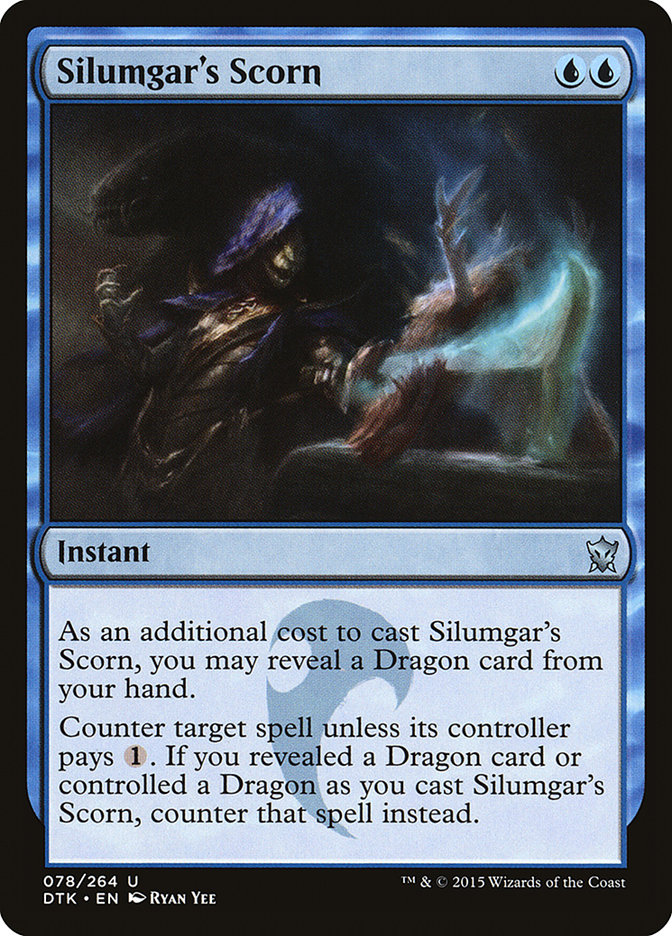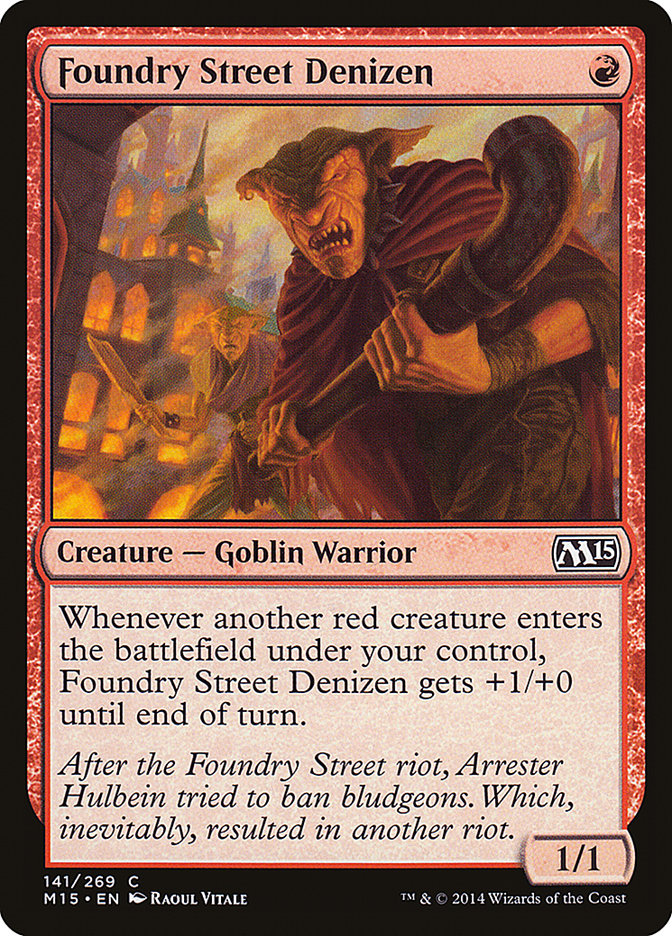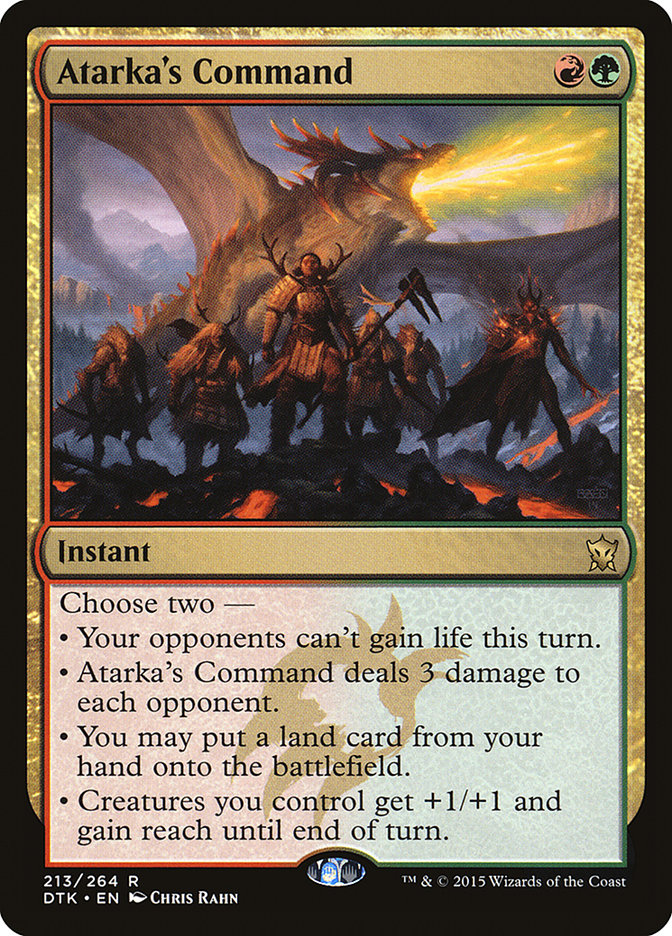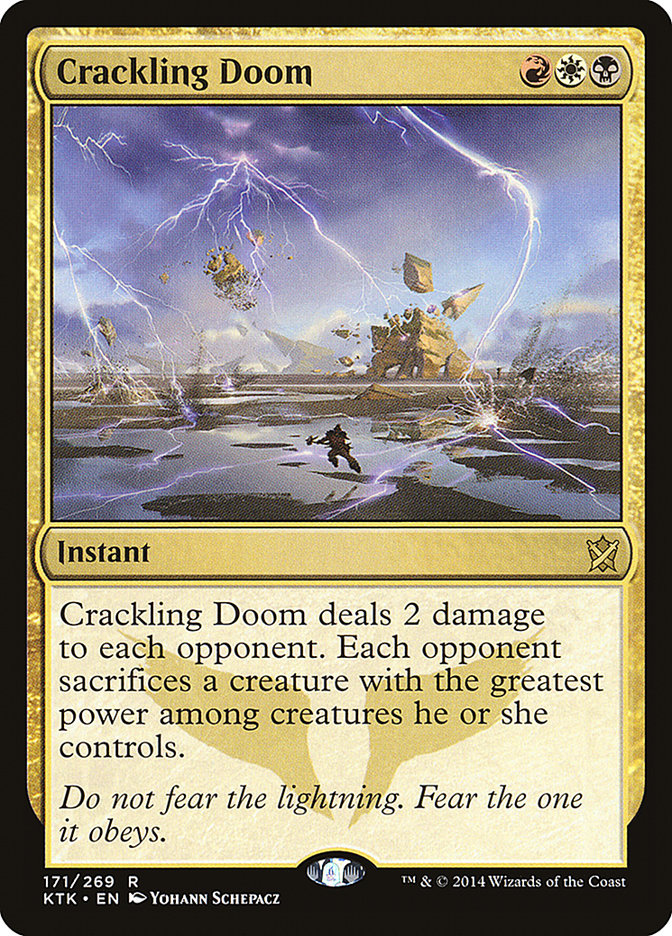This last weekend was the first Regional Pro Tour Qualifier weekend. Ladies and gentleman, we now have an idea of what the new world of RPTQs might be
like.
I, for one, was rooting for a lot of people, but none as much as my friend and teammate Matt Severa. Alas, it was not to be, though one of the 112 players
in the Chicago RPTQ was a Madisonian, so at least there was a minor consolation prize. Still, seeing your friends qualify for the Pro Tour is one of the
best possible outcomes of a Magic weekend.
This RPTQ weekend resulted in 132 invitations to the Pro Tour. Let’s take a closer look.
The Big Picture
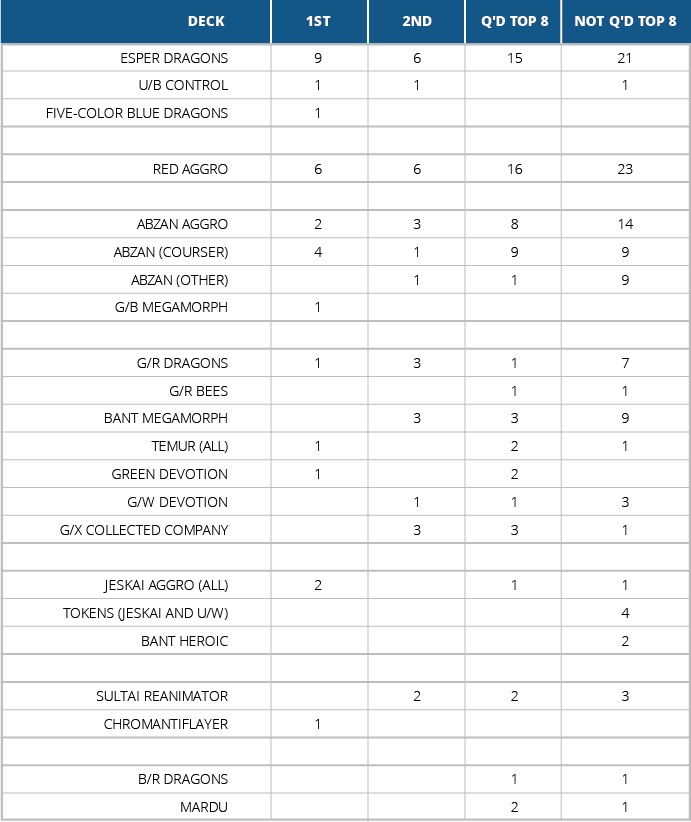
The very simplest narrative goes something like this: Esper Dragons utterly dominated the weekend, and while Red Aggro (mostly with Atarka’s Command) was
the next most likely deck to finish in first place at an RPTQ, Abzan variants, in all of their many varieties, qualified nearly as many players as Esper
Dragons.
Here is the most general view:
The Big Three
Blue-based control: 11 champions, 33 qualifications, 55 Top 8s
Abzan variants: 7 champions, 30 qualifications, 63 Top 8s
Red Aggro variants: 6 champions, 28 qualifications, 51 Top 8s
The Rest
Green Midrange (all varieties): 3 champions, 26 qualifications, 48 Top 8s
Blue Aggro (Jeskai varieties, Heroic): 2 champions, 3 qualifications, 10 Top 8s
Non-Abzan graveyard decks: 1 champion, 5 qualifications, 8 Top 8s
Black/Red(/x): 0 champions, 3 qualifications, 5 Top 8s
This makes a lot of sense to me. The various blue-based control decks, led almost entirely by Esper Dragons, were not only the targeted best deck, but in
practice, they ended up being the best deck. This, in turn, set up a Rock/Paper/Scissors between Red Aggro and Abzan variants, albeit with Abzan variants
more likely to upset the pecking order.
As for “The Rest”… well, these decks simply aren’t able to compete nearly as well as the others. It can kind of be summed up like this:
Beating all three of these cards is very, very hard.
A Little Closer Up
There is more to the tale, of course, as we get closer up.
I’ve taken a hard look at the top 8 data from the field, and it is easy to see why the story is less about the green decks with 26 qualifications, and it
really does have more to do with the Big Three of blue-Based Control, red aggro, and Abzan variants. It’s simply visually obvious how much better that top
three did than everything else combined.
While we can’t hit every deck that did well, we can talk a little about each.
Creatures (5)
Planeswalkers (1)
Lands (27)
Spells (27)

In New Mexico, it wasn’t just Esper Dragons that got first. They also got second, third, and fourth, knitting up all of the invitations. Zachary’s build,
for the most part, is pretty standard for the archetype, with very few of the bells and whistles that you see in other builds (things like Risen
Executioner), though he does have a single Ashiok, Nightmare Weaver to help fight the mirror that little extra bit more.
If you look at all of the Esper Dragons lists, the likelihood is that, among their 75 cards, they are no more than eight cards off of this one.
The talk of the weekend, though, might be this deck:
Creatures (10)
Planeswalkers (1)
Lands (27)
Spells (22)

Now, this is quite a deck!
My old co-editor Michael Flores took down a Pro Tour slot with this intriguing Dragon-based control deck that one of my friends called “Flores’s Five Color
Mono-Blue Dragon Control.” If you read the full story of the deck,
there is more to it than that, of course, but it is a fun collection of words at least.
One of the things that I absolutely love about this deck is this card:
In a way, it reminds me of my Time Spiral Block version of Baron Harkonnen, with this card:
Inevitably, when I played against other decks, I’d build up my counters on the Reef, and it would represent a huge swing in the game many, many turns
later, as I set up some ludicrous double-threat that they couldn’t possibly answer. In the same way, Flores is able to work the same Magic.
This is a great deck, and I expect to see much more of it in the weeks ahead, as it purportedly preys upon Esper Dragons. I haven’t had the chance to take
it for a spin yet, but I intend to!
Red Aggro is the next deck on the docket, and this came in two clear varieties: those that played with gold, and those that didn’t.
Most of these decks, by more than an overwhelming two-to-one margin, played with Atarka’s Command, in essence, looking very much like Martin Dang’s Pro
Tour winning list.
Here is the winning list from Montreal:
Creatures (14)
- 1 Frenzied Goblin
- 4 Foundry Street Denizen
- 2 Goblin Rabblemaster
- 4 Monastery Swiftspear
- 3 Zurgo Bellstriker
Lands (20)
Spells (26)

The only difference in the maindeck for Alexander and for Pro Tour Champion Martin Dang is that Alexander has removed a Lightning Berserker in favor of a
second Become Immense. While this can introduce some greater swings into the deck with the power of Become Immense, the downside is that the deck will
often have difficulty casting that second one, should it draw it.
Of course, hopefully the first one killed them!
If you’re looking to prey on Esper decks, this is the one to go with. Of course, you might just end up getting wrapped up in some variety of your Paper…
Creatures (20)
- 4 Fleecemane Lion
- 4 Anafenza, the Foremost
- 2 Wingmate Roc
- 4 Rakshasa Deathdealer
- 4 Siege Rhino
- 2 Tasigur, the Golden Fang
Lands (25)
Spells (15)

Abzan Aggro can sometimes be a real challenge for Red Aggro, as the cards it is playing can so easily get eclipsed. Then, with a deck like Hiroshi
Kawakami’s deck, you have even more to contend with than usual:
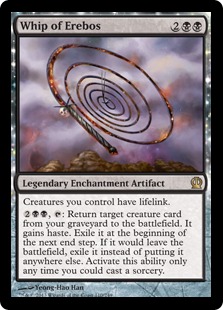

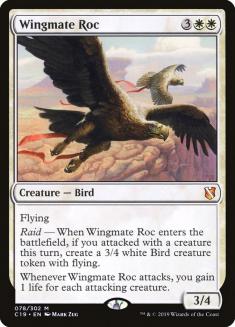


Yikes. Talk about rough for red! If you’re the hapless Red Aggro deck, you already have to contend with four copies of Siege Rhino and cheap, powerful
creatures. Whips and Rocs can steal even more games away.
Besides Abzan Aggro, there are many other varieties of Abzan. These days, the distinction between what is Abzan Midrange and Abzan Control often revolves
on whether or not the deck chooses to run End Hostilies/Crux of Fate or not. What they all have in common, though, is this:
Here is one example, the winner in Greensboro, David Jones:
Creatures (13)
Planeswalkers (3)
Lands (25)
Spells (19)
- 4 Thoughtseize
- 1 Ultimate Price
- 2 Read the Bones
- 3 Hero's Downfall
- 2 Bile Blight
- 1 Utter End
- 1 Murderous Cut
- 4 Abzan Charm
- 1 Foul-Tongue Invocation
Sideboard

This build runs the Read the Bones that often marks the control side of the line between what we’re calling “Abzan Midrange” or “Abzan Control,” but it
doesn’t run End Hostilities or Crux of Fate, leaving that in the board. Instead, it runs Utter End and Foul-Tongue Invocation, the latter clearly targeting
the dreaded enemy number one, Dragonlord Ojutai.
For a different reason than the Abzan Aggro list, this list looks quite frightening for a Red Aggro list. In addition to a large amount of creature hate,
it also runs Drown in Sorrows in the sideboard and Arashin Cleric. These days, Arashin Cleric is probably the go-to dedicated anti-red card, and
while it is not Timely Reinforcements, it is still a kick to the teeth for these small-critter-based red decks.
One other incredibly interesting deck is the championship deck from Toronto:
Creatures (26)
- 4 Courser of Kruphix
- 4 Satyr Wayfinder
- 4 Rattleclaw Mystic
- 3 Whisperwood Elemental
- 1 Tasigur, the Golden Fang
- 1 Merciless Executioner
- 1 Sidisi, Undead Vizier
- 4 Den Protector
- 4 Deathmist Raptor
Lands (25)
Spells (9)

Yowsa!
I grouped this in with the Abzan lists because the core of the deck is similar to many of the Abzan Megamorph lists. Kai Burnett’s list does some
wonderfully creative things, fueling a Megamorph strategy with all eight of the great megamorphs (Den Protector and Deathmist Raptor), plus three
Whisperwood Elemental to keep the deck flush in potential Deathmist Raptor reanimation.
Of all of the cards in Kai’s 75, I love Dictate of Erebos the most. I’ve been trying to find a home for this card for a long time. If you’ve ever suffered
under Grave Pact, you know how horrible it is to fight against.
Dictate of Erebos is to Grave Pact what Dig Through Time is to Ancestral Memories. Being able to play the card as an instant is just incredibly powerful,
and it is very easy for me to imagine Kai utterly wrecking people after sideboard with this card.
Think about it like this: If you’re Esper Dragons, how do you possibly beat this card if G/B Megamorph is doing anything else?
When it comes to other green champions, there were only two: a Green Devotion deck in Rome and a G/R Dragon list in Melbourne. Otherwise, altogether, the
green archetypes really fell flat.
Here is that winning list from Rome, incidentally, the site of the second largest RPTQ in the world, behind Tokyo.
Creatures (33)
- 1 Hornet Queen
- 4 Elvish Mystic
- 4 Polukranos, World Eater
- 4 Sylvan Caryatid
- 2 Boon Satyr
- 4 Courser of Kruphix
- 1 Genesis Hydra
- 4 Rattleclaw Mystic
- 4 Whisperwood Elemental
- 3 Dragonlord Atarka
- 2 Surrak, the Hunt Caller
Lands (23)
Spells (4)

This list is quite similar to Pro Tour Dragons of Tarkir semifinalist Ondrej Strasky’s list, with one less land and one less Dragonlord Atarka in favor of
a single Genesis Hydra and Hornet Queen.
There are some truly targeted ways to fight an opponent in the mirror. Mistcutter Hydra and Nissa, Worldwaker both have Esper Dragons written all over
them. Conversely, Nylea’s Disciple and Seismic Rupture both have Red Aggro’s number.
If you’re looking for a non-Abzan green-based strategy, this is probably the one, though personally, I think you’re better off betting with the Big Three.
Odds and Ends
Aside from these big decks, aside from Kai Burnett’s G/B Megamorph, there were some strange ones out there that saw some success. I’m going to examine just
a few.
For example, have you been looking for a list with this card?
Look no more.
Creatures (14)
Planeswalkers (1)
Lands (24)
Spells (21)
- 3 Thoughtseize
- 3 Lightning Strike
- 4 Stoke the Flames
- 4 Crackling Doom
- 3 Hordeling Outburst
- 1 Valorous Stance
- 2 Wild Slash
- 1 Secure the Wastes
Sideboard

Four Crackling Doom can begin the end for a Dragonlord Ojutai player. This deck is basically very classic, with only a single Secure the Wastes (known as
“Secret W” in our team’s playtesting) to remind us that Dragons of Tarkir is in the mix game 1.
I like the look of this deck. It isn’t fooling around, and it is just making use of simple, powerful cards, with the understanding that right now might be
the time for Crackling Doom. Well done work by Huang Yung-Ming.
For a different take, Robbie Cordell’s deck did something slightly different in Nashville, though of much the same vein:
Creatures (10)
Planeswalkers (2)
Lands (25)
Spells (23)

This build is a little more wild than the first one, but the concept is effectively the same. Instead of Secure the Wastes representing for Dragons of Tarkir, we see maindeck Kolaghan’s Command. Even without Secure the Wastes, though, this version seems more intent on both creating
tokens and generating card advantage. There are a lot of ways to gain card advantage in this deck, and I’d be unsurprised if they weren’t a big
part of what propelled Robbie to the Pro Tour.
Finally, we have the rebirth of The Pantheon’s Chromanti-Flayer deck in first place in Kansas City in the hands of Ryan Overturf.
Creatures (22)
- 4 Sylvan Caryatid
- 4 Chromanticore
- 4 Satyr Wayfinder
- 4 Sagu Mauler
- 4 Soulflayer
- 2 Tasigur, the Golden Fang
Lands (20)
Spells (18)
Sideboard

This deck gives me a huge chuckle, and I find myself wondering just how often Soulflayer was in play on turn 3 doing something absurd.
I don’t think I could get myself to play this deck, but the essential parts that make this deck function are absolutely completely rational. If you do play
it, you might want even slightly more in your board for Red Aggro than Ryan ran, but maybe I’m just being overly paranoid about the deck’s complete
reliance on the full Soulflayer + Chromanticore combo being necessary to win that matchup.
The Future of RPTQs
Many of the times that I qualified for the Pro Tour, I did it by winning a PTQ. This last Pro Tour, Dragons of Tarkir, I qualified for during the last full
season of “true” PTQs, which existed concurrent with the beginning of the PPTQ/RPTQ system. I’ve played in several PPTQs so far (my friend Nicolette
insists they are best called “Pre-TQs”), with a couple of Top 8s, though I’ve won none of them.
Something definitely had to give with the old system. I am curious what this will mean for a new system, though.
As I said earlier, under the new system, RPTQs invited 132 players to the Pro Tour worldwide. Dragons of Tarkir PTQs, in contrast, awarded 92 players to the Pro Tour. When I
found this out, I was actually quite surprised, as I had expected there to be a drop in invitations. This, at least, was a bit of good news.
To feed into the RPTQs, you have two groups of people: PPTQ winners and Silver-level members of the Pro Players Club. According to one projection, based
on the number of PPTQs and Silver Pros, there would be 2291 players vying for those slots. In the end, a little more than 15% of those players decided not
to attend an RPTQ – “only” 1923.
There are probably a lot of reasons for this. For some people, it may have simply been their schedule. Perhaps that weekend was busy, and they couldn’t
attend another event. For others, it may well have been that they simply had no interest in a longer trip. They won the Big Deal event at their store, and
that was enough for them. A larger event quite a ways away might not have been their cup of tea.
When you compare the projections to the attendance, it really is quite interesting.
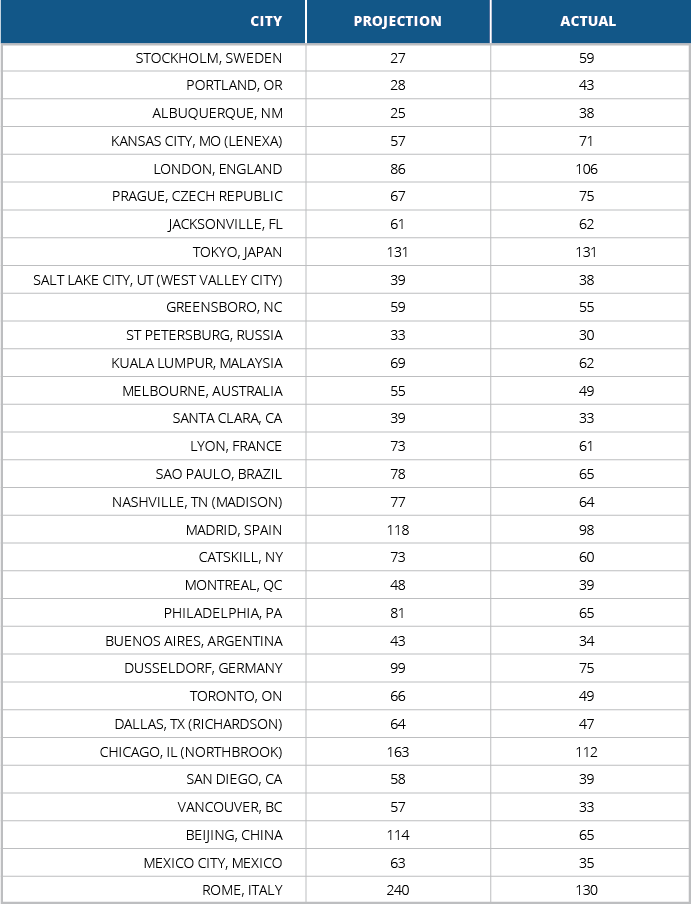
Looking at the attendance data, I found that the three smallest projected events had the wildly largest percentage of attendance over the projection. This
might seem like it would be obvious, until you notice that the next smallest events were in much more remote areas. This does mean that people absolutely
“poached” events, traveling to Stockholm, Portland, and Albuquerque with the intention of having an easier event. I know that, for me, I had intended to do
the exact same thing, and if I’d needed to, I was planning on flying to Portland to visit friends and play in an RPTQ.
The mathematical hardest RPTQ in the world was in Chicago, with 112 competitors giving out only 4 slots. Wherever you set the line, there will always be
events that fall just below the line for the next level of reward, but with less than 4% of all of the competitors qualifying, that has to be pretty damned
disappointing. For context, the mean was almost 7%. My friend and Team Ultra Pro teammate Brian Kowal, made a good point when he suggested that the 8-slot
mark be reduced to where there was a natural break between small and large events. Looking at the numbers, it would appear that number is about 90. 96
would put it evenly in the middle of 64 and 128 (two spots where extra rounds get added), and either way, making this the mark would have increased the
8-slot events from two to five. It’s a small amount, but it does make the biggest events less unsatisfying in their reward.
My biggest worry for these events largely has to do with what is feeding them: the PPTQs. I can’t speak to nationally or internationally, but locally,
we’re seeing a shrinkage of stores willing to run PPTQs. For the most part, stores that earn the privilege of hosting these events are often discovering
the events aren’t as profitable as they expected. Stores aren’t accustomed to the prospect of paying a qualified judge what many judges consider to be a
proper amount. Attendance wasn’t what it was expected to be. Simply put, there are seemingly many store owners who are disappointed and might not be
offering these events going forward.
If that continues, it just means less opportunities for people to qualify. I hope it doesn’t come to that. If it does, hopefully Wizards of the Coast will
come up with an appropriate solution of some sort.
The Quest for Platinum
As you read this, it is likely that I am on the road to Toronto. After my finish in Brussels at Pro Tour Dragons of Tarkir, I’m in a position to attempt to
chase Platinum status. If you like, you can keep track of my progress on my Facebook
page. As of today, I have 32 Pro Points. There are more than a few months until Pro Tour Magic Origins, so this is definitely something I can
achieve.
See you in Toronto! Wish me luck!


